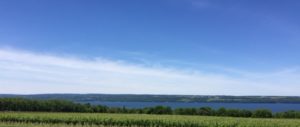What’s New in the Finger Lakes
I’ve visited the Finger Lakes of New York off and on since 1982. At that time, native grapes like concord, niagara and catawba led production, while hybrids like seyval blanc, baco noir and de chaunac were the strong suit for quality table wines, symbolized by (now defunct) Gold Seal, Great Western and Taylor (then owned by Coca-Cola). The producers of classic European vinifera wines were just a handful: Dr. Frank Vinifera Wine Cellars and Heron Hill Vineyards on Keuka Lake, Hermann J. Wiemer, Wagner and Glenora Vineyards on Seneca Lake.
Since then, it’s been a sea change. The large corporations who owned the large local wineries sold them, and they’ve been replaced by something like two hundred small to mid-sized wineries mostly specializing in cold-hardy vinifera classics like riesling, chardonnay, pinot gris, pinot noir, merlot and cabernet franc, often supplemented by cold-hardy hybrids like seyval and cayuga blanc, chambourcin, and in the last few years, newer hybrids from Cornell like valvin muscat, aromella and arundell for white grapes, and corot noir and noiret for red grapes.
While riesling is still justifiably the royalty of grapes in the Finger Lakes, making classic, brilliant and briskly acidic grapes from bone-dry sparkling to “trockenbeerenauslese” exquisitely sweet and concentrated dessert wines, the vinifera scene has become more diverse, complex and increasingly, higher quality (reflected in the prices). At the same time, brilliant wines continue to be made with varietal and blends of the best hybrid grapes, which also offer the best value for quality wine.
Here are a few of the trends I’ve noticed since my last visit two years ago:
- The resurgence of Finger Lakes sparkling wines. This matches the big demand for sparkling wine worldwide. Excellent examples range from $35.00 to $12.00 depending on the process, the grape varieties and the length of time aged in bottle.
- Rosέ For about five years now, the region has gotten on the rosέ bandwagon, through the vision of those who realized that it was non-varietal specific, and could apply from a blush concord to a dry cabernet franc, with all having the bright fruit and lively acidity for which Finger Lakes wines are known world-wide. Geneva, NY on the north end of Seneca Lake has hosted a “Rose Soiree” for a few years in early June on Linden St., a quaintly urban and chic way to host a local wine festival.
- More Blends. In hybrids and vinifera wines, reds, whites and rosέs, there are many more blends than there used to be, and now it’s about creating ideal balance instead of just using up odd ends to fill a bottle. Some of the best wines in the Finger Lakes are now blends.
- More Single Vineyard Labels. As you’d expect, this helps distinguish these wines from blends of the same grape in the market, and it’s well that the growers are getting the respect (and money) they deserve for these wines.
- More Diversity. There are fun vinifera red grapes increasingly showing up in top wines, from lemberger a k a blaufränkisch, to syrah, gamay and malbec. Also, the Ukranian grapes rkatsiteli and saperavi are showing up in diverse styles.
- Chardonnay Re-discovered. It was delightful to taste so many well-made unoaked or lightly oaked chardonnays that really hit the nail on the head for showcasing the best of the grape (tasting more like fine pinot blanc with zesty lemon) with just enough oxygen in neutral (French) oak and just enough hint of yeast to add complexity without over-doing it.
- Merlot Matters. As in Virginia, this classic grape is being re-discovered and made more skillfully than ever before, either as a straight varietal or in meritage blends. The merlots I’ve tasted on this trip are the best I’ve ever had from the Finger Lakes. Unfortunately, merlot is winter-tender and therefore will remain in limited supply in this northern region.
Follow this blog for regular installments as I recount my tasting travels lake-by-lake.

